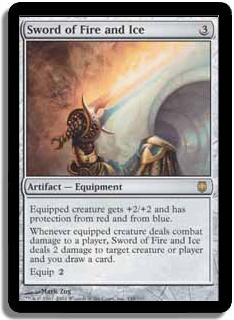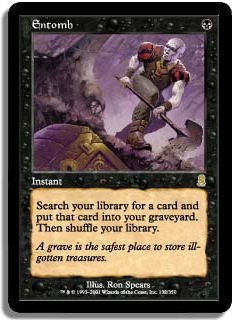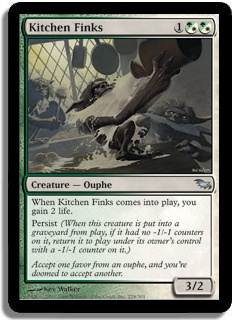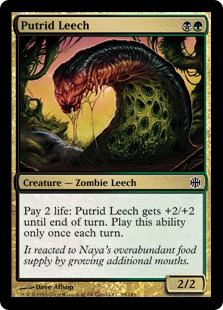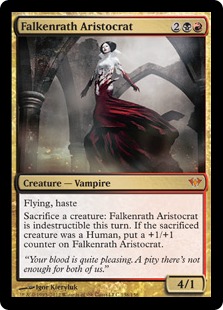If you’ve logged on to Magic Online in the past week, I bet you’ve done at least one Cube Draft. If you’re like me, then you probably find it hard to join any tournament except Cube. The worst part is that Cube has an effect on the Magic Online economy that makes it a bad financial decision every time you join a Cube Draft. Winning an 8-4 Draft means that you break about even and everything else is a loss, never to be recouped. I’m more than willing to pay to have fun, but the bad Cube economy only motivates me to win more.
One of the defining features of Cube is redundancy. This might seem strange since there is only one copy of each card in a cube, but you can have many “virtual” copies of one effect. While there are obvious differences, it doesn’t really matter that much which two of Lightning Bolt, Chain Lightning, Incinerate, and Volcanic Hammer you have in your R/G deck or whether that blue control deck has Thirst for Knowledge, Compulsive Research, or Careful Consideration. Many of the obvious (and very good) archetypes take advantage of these redundancies. A green creature strategy with all three of Birds of Paradise, Noble Hierarch, and Avacyn’s Pilgrim starts to feel like a Constructed deck pretty quickly.
Every card in a cube is good. That’s why it’s in the cube. It may be simplistic, but drafting a good stuff deck just isn’t going to cut it when every card is playable and you always have enough of them. Taking the best card out of each pack or even the best card in one color out of each pack is a good way to lose a Cube Draft. There will be situations where you’re taking Keldon Marauders over Flametongue Kavu, and that’s something you have to get used to. The old adage of “draft a deck, not cards” applies more to Cube Draft than any other format.
So you’re looking at a format where are all the cards are good and many of them are redundant. What does that mean? How should you approach the draft portion? One way is to prioritize unique, high impact effects. You know that you’re going to get enough removal spells and creatures to fill out your curve, but that’s not true for other types of cards. Some examples of unique and powerful cards that I like to start a draft out with are Armageddon, Vedalken Shackles, Sword of Fire and Ice, and Garruk Wildspeaker. Another option would be to take a card that is key to a particular archetype, such as Sulfuric Vortex, Entomb, or Primeval Titan.
A different approach to a format where everyone has access to powerful cards is to build a deck that is able to cast powerful spells earlier or more consistently than your opponent. This typically means placing a priority on mana, valuing cards like Birds of Paradise, Grim Monolith, Ancient Tomb, and even Rampant Growth highly. Other effective strategies take advantage of mana by being low curve, consistent, and mono-color. Aggressive mono-red, white, or black decks are good examples of this.
Now that you’ve got a general idea of the format, let’s talk a bit about a few of my favorite archetypes.
Green/X Ramp
In my opinion, this is the default best deck. There is a tremendous amount of redundancy in terms of mana acceleration and a number of powerful and interchangeable threats that end the game quickly. One of the advantages to this deck is that it is able to go “over the top” of pretty much every other strategy, typically via the two cube Eldrazi, Kozilek and Ulamog, or Genesis Wave. Other top end threats include Tooth and Nail, Sundering Titan and Terastodon in addition to the usual suspects like Wurmcoil Engine and Primeval Titan.
When drafting this deck, you typically draft three types of cards: threats, mana, and defensive cards. This deck is typically pretty good at beating the mono-red decks because it has access to life gain like Kitchen Finks, Obstinate Baloth, and Primal Command in addition to early blockers in Wall of Roots and Sakura-Tribe Elder.
One of the best cards for the archetype is Channel. Not only does it let you power out huge threats reasonably early or fuel a big X-spell, but it gives you free wins. Very few things beat turn 2 Karn, Ulamog, or Kozilek.
A recent example of this deck from my draft archives is:
Creatures (13)
- 1 Llanowar Elves
- 1 Wall of Blossoms
- 1 Wood Elves
- 1 Fyndhorn Elves
- 1 Sundering Titan
- 1 Cloudthresher
- 1 Thornling
- 1 Kozilek, Butcher of Truth
- 1 Overgrown Battlement
- 1 Obstinate Baloth
- 1 Palladium Myr
- 1 Myr Battlesphere
- 1 Primordial Hydra
Planeswalkers (1)
Lands (16)
Spells (10)
- 1 Heartbeat of Spring
- 1 Plow Under
- 1 Tooth and Nail
- 1 Rampant Growth
- 1 Kodama's Reach
- 1 Moment's Peace
- 1 Rude Awakening
- 1 Lightning Greaves
- 1 Search for Tomorrow
- 1 Primal Command
Sideboard

Jund (R/G/x Midrange)
This deck is typically pretty aggressive, taking advantage of lots of undercosted or hasty creatures. I like this deck because it feels less “all-in” than the red deck, as it is more resilient against control decks. Some of the other aggressive decks fold to a single Loxodon Heirarch or Wrath of God, which isn’t true for this archetype. The combination of removal spells and big green creatures is usually enough to provide an advantage in matchups against the red or white aggro decks.
This deck is also able to take advantage of mana acceleration, though in a less unfair fashion that the true ramp decks. One-drops like Birds of Paradise and solid ramp such as Explore still have a home in these types of decks. The reason I refer to this deck as “Jund” is that I usually find myself with a small to moderate black splash. The midrange decks need some amount of disruption to survive against unfair strategies, which typically comes in the form of discard or land destruction. When the mana works out, midrange green decks are also able to play powerful cards that few other strategies support, like Putrid Leech or Falkenrath Aristocrat.
Here’s a Jund deck a drafted just the other day:
Creatures (13)
- 1 Birds of Paradise
- 1 Grim Lavamancer
- 1 Elves of Deep Shadow
- 1 Werebear
- 1 Boggart Ram-Gang
- 1 Broodmate Dragon
- 1 Sprouting Thrinax
- 1 Fauna Shaman
- 1 Obstinate Baloth
- 1 Thrun, the Last Troll
- 1 Urabrask the Hidden
- 1 Falkenrath Aristocrat
- 1 Hellrider
Lands (17)
Spells (10)
- 1 Rancor
- 1 Incinerate
- 1 Terminate
- 1 Call of the Herd
- 1 Molten Rain
- 1 Primal Command
- 1 Bituminous Blast
- 1 Green Sun's Zenith
- 1 Go for the Throat
- 1 Brimstone Volley
Sideboard

U/W Tempo
What else? I love playing this deck in any format, and sometimes you just decide to first pick Stoneforge Mystic and hope.
Some of the underrated cards in this archetype are Force Spike and Mana Tithe. The fact that you can play a threat and have a cheap counter available is what makes this deck so good. In general, most opponents will have lots of powerful spells, and try to maximize their mana whenever possible. As a result, Force Spike and Mana Tithe are usually huge blowouts.
I lost in finals with this deck and was very happy with it.
Creatures (14)
- 1 Ninja of the Deep Hours
- 1 Isamaru, Hound of Konda
- 1 Exalted Angel
- 1 Solemn Simulacrum
- 1 Willbender
- 1 Voidmage Prodigy
- 1 Jushi Apprentice
- 1 Mystic Snake
- 1 Old Man of the Sea
- 1 Aven Mindcensor
- 1 Mirror Entity
- 1 Emeria Angel
- 1 Stoneforge Mystic
- 1 Snapcaster Mage
Lands (17)
- 1 Forest
- 7 Plains
- 7 Island
- 1 Savannah
- 1 Flooded Strand
Spells (9)

Storm
Don’t draft this deck. Everything has to go right, and it almost never does. Plus, there’s always a chance that Tendrils of Agony isn’t even in the draft, in which case you basically can’t win. That said, it worked exactly once for me, and I managed to take a screenshot.
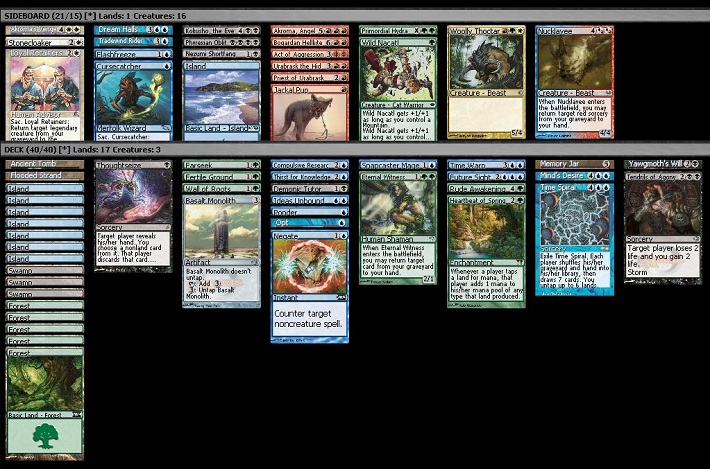
There are a million different archetypes in Cube. I find it particularly fun and interesting to draft the same archetype a few times in a row or within a few drafts of each other to really get a feel for the ins and outs of that deck and what cards are important. I started off not liking midrange decks at all, but after my experiences drafting Jund and R/G many times, I think they are a lot better than I would have ever given them credit for. You can lose to the unfair decks, but I like playing midrange against basically every other “fair” archetype in the cube.
Hopefully you’ve learned a bit about cube drafting and maybe have some ideas of cards to pick more highly or archetypes to try out. Don’t be afraid to try new things. There are boundless options in Cube, and you haven’t lived until you’ve tried to force Storm and failed. Sometimes, you just have to Mind’s Desire to into Thirst for Knowledge and Reanimate.
Thanks for reading,
Matt Costa


